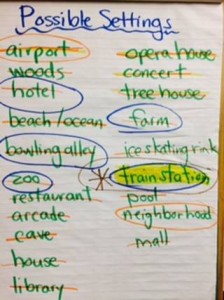Students must clearly understand setting and how it can enhance the plot and illuminate character relationships, conflict and resolution. We revisit books we have used for multiple purposes and focus on setting as an essential element in telling the story. Citing specific text and illustrations that give clues about time and place serve to clarify the interdependence of setting and other elements of a story. While reading and listening to Mozart’s Magic Flute, students create detailed drawings illustrating their vision of setting as portrayed through textual clues. They are now ready to move forward in the selection process.
In determining a setting for the opera, several criteria are considered. The place is realistic not fantastical. We want kids to be deeply connected to and aware of the realities in their own lives. In this way, students learn to manage emotions and situations in their daily lives.
The setting must be a place students have been and know well or could visit to do research. It should not be “tired”, the common settings in everyday life that are often mundane and offer little spark to the imagination or curiosity. And, it should be a place where students can imagine the conflicts between our opera characters coming to life.
Students begin by brainstorming an initial list of possibilities. Discussion ensues and the elimination process commences. Any setting that does not satisfy the criteria above is deleted from the list unless adequate and reasonable defense is given. Several options remain. Which of the remaining settings would provide a powerful metaphor to illuminate our thesis, “reconnection causes mixed emotions”? After small group discussion, significant justification for two ideas draws us into debate. Bowling Alley or Train Station? A tapeline separates the opposing viewpoints. Attempting to persuade their peers, students mount arguments and counter arguments defending their preference.
Arguments for Bowling Alley:
Arguments for Train Station:
If you present a convincing argument, I may cross the line and move to your side. If not, I will stand firm in my conviction. Within thirty minutes, a decision is apparent, as represented by the number of physical bodies intentionally positioned on the side of “train station”.
